Cleaning your wine glasses aren’t necessarily as complicated as it may seem. Here’s how to best wash your wine glasses.
- Your dishwasher’s glassware programme
- Dishwasher-proof wine glasses
- Washing your wine glasses by hand
- Wine glasses in the dishwasher
- How to wipe your wine glass
- How to store your wine glasses
- How to ready a wine glass
- Fact box
After a pleasant evening with great wine and great company, the washing-up of the many wine glasses may be lurking at the back of the mind of the host. If you’ve gone all in on treating your guests and yourself to anything from welcome drinks, champagne, white wine, red wine, dessert wine and Digestive for your coffee, it’s probably been a great night. However, the sad remains on your kitchen table may easily look like the repercussions from all the Queen’s New Year’s receptions
Your dishwasher’s glassware programme
The pile of wine glasses may seem insurmountable at the thought of doing it by hand, but it doesn’t have to be that way. The very best friend of your wine glasses is in fact your dishwasher – if you have one.
There’s no problem in washing your wine glasses in your dishwasher. Especially if it’s got special programmes for glassware at a sufficiently low temperature.
Whether you decide to wash your wine glasses by hand or you prefer the dishwasher, there are a few tips and tricks which may guide you to the best way to clean your glasses.
Dishwasher-proof wine glasses
The vast majority of the world’s largest producers of wine and drinks glasses state that their glasses are completely dishwasher-proof.
If the producer isn’t straight-out recommending that you go with the dishwasher, at least it’s tolerated by most products.
The giant glassware producers like Spiegelau, Riedel (video with CEO Maximilian Riedel), Zalto and Lucaris (guide to cleaning your glasses) recommend that you wash your wine glasses in a dishwasher. No matter which option you choose, it’s always a good idea to check the producer’s guidelines.
Washing your wine glasses by hand
Here we give you a bulleted list of things to remember when washing your wine glasses by hand. So, if you prefer to do the cleaning of your wine glasses this way, you’ll get the best results by following this little guide.
- If you can’t be bothered to do the washing-up immediately, there’s no problem in leaving the glasses overnight with remains in them. In fact, dried-up wine puddles are much to prefer over the chalky remains left by water
- Washing-up liquid without perfume is the best thing to clean your glasses with
- Use a clean washing-up brush or a new sponge
- The water shouldn’t be too hot. 40 degrees Celsius is perfect.
- Gently clean the glass in a tub and rinse with clean water.
- Wipe and polish the glass in a large, lint-free tea towel. The wiping technique is something we’ll look into later in this article. Easy does it!
- The glass shouldn’t smell of anything; particularly not of washing-up liquid or fusty old tea towel.
- Place the glass facing the right way up. In that way, excess dampness will be able to evaporate.
Wine glasses in the dishwasher
In the past, the dishwasher has been considered an absolute no-go when it came to the cleaning of wine glasses. That scepticism was understandable to a certain degree since dishwashers back then didn’t have the advanced programmes for cleaning glassware that they do today.
Fortunately, there’s no shame in being a bit lazy nowadays. On the contrary, in fact, because dishwashers and glass producers are great friends these days. The restaurant business cleans wine glasses at high temperatures but for a short period of time. The reason is that the combination of time and temperature is the key. As well as softening units at an industrial scale, but that’s a different story.
There are a couple of clever tricks to ensure that your glasses have a wonderful time in the dishwasher. Check out our quick guide for a good washing-up in the machine.
Washing your wine glasses in the dishwasher
- Make sure that the machine has been set correctly according to the hardness of your local water and that it has been topped up with rinse aid and salt. You can check the hardness of your water here at GEUS. Make sure to follow the instructions in your dishwasher manual as well.
- Only fill your machine with wine glasses. No pots, bowls or plates along with them.
- Place the wine glasses well so that they’re stable. Make sure they aren’t touching by providing plenty of room around each glass. Being too eager and trying to force in an extra glass is no great idea. Rather too much room than too little.
- Use the dishwasher programme specifically for glassware or make sure that the temperature doesn’t rise over 45 degrees Celsius and keep the washing time short if your machine has no specific programme.
- As soon as the programme has finished, open up so that the glasses may cool down for a couple of minutes.
- Now carefully wipe the glasses with tea towels. We’ll look at the wiping technique in a separate paragraph.
- As with washing-up by hand, leave the wine glasses to breathe, meaning not facing downwards.
How to wipe your wine glass
In order for you to wipe your wine glasses efficiently without breaking them, we’ve put together a handful of tips.
- Tea towels and polishing cloths should be washed in perfume-free laundry detergent, and fabric softener is no-go.
- Use lint-free pieces of cotton fabric or micro fibre tea towels. Micro fibre cloths for cleaning are brilliant, especially the ones designed for cleaning glass surfaces like mirrors and the like.
- We recommend you use two polishing cloths of a decent size, one for each hand. Otherwise one very (!) big piece may do the job. ´
- Here’s the trick! Hold the glass around the bowl when wiping. The most common cause of broken wine glasses is twisting the glass. It’s very easy and tempting to twist the bowl and stem in opposite directions when wiping. This, however, is also a highly effective way to break a good glass as you’ll easily exaggerate the motion.
- If possible, try to have polishing cloths which you only use for wiping wine glasses and decanters.
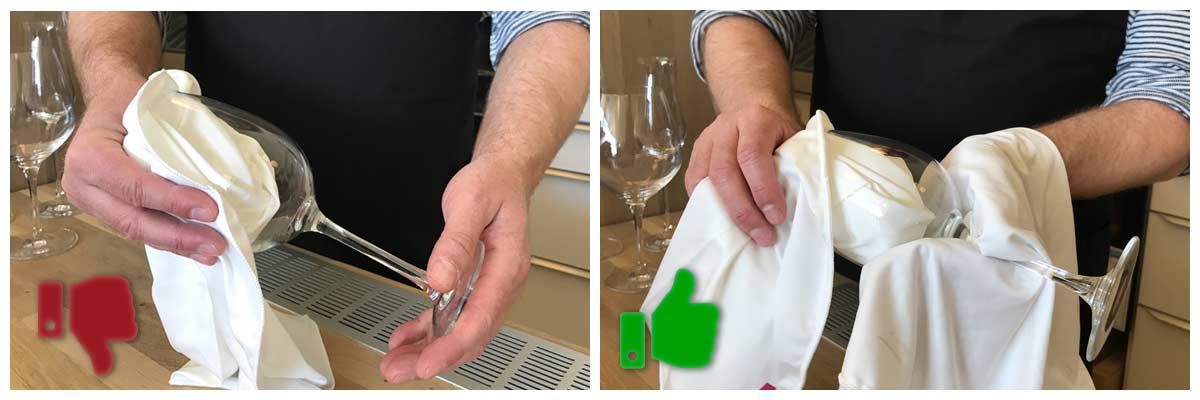
How to store your wine glasses
Any kind of glass, including wine glasses, prefers being stored foot down. This allows the glass to get rid of excess damp, and you avoid your glass absorbing odour from the cardboard box or cupboard in which it’s kept.
Yet, make sure to sniff the glass before using it. Spending time in a cardboard box or a wooden cupboard may give the glasses an unwanted odour.
How to ready a wine glass
Normally, it’s easy to get rid of smells by rinsing the glass in a bit of water and wiping it.
Or you might want to do as the professionals in the business, the sommeliers. If needs be, any serious sommelier will “rinse” the glass with wine before serving by twirling a bit of wine in the bowl.
You could do the same and afterwards pour it into the sink or your mouth.
Go great guns with glasses
As you can see there’s absolutely no reason why you shouldn’t go all in on wine glasses when laying the table. You may calmly enjoy pleasant company, delicious food and marvellous wines.
The kitchen table is completely covered with glasses, and your guests cheekily wish you a good time washing up.
This is the exact moment you’re going to seize, and you’ll put on a martyred air and willingly do the dishes for the benefit of your fellow human beings.
Why your wine glasses look weird
Dull or foggy glasses after dishwashing
Either your glass has become lime scaled or it has been attacked by white haze. The dull, foggy and milky surface which glass may develop after frequent visits to the dishwasher is basically caused by two things: lime or white haze. One is easier to get rid of than the other because they’re not the same thing.
White haze (ghosting) on wine glasses
White haze appears as a white stripe near the rim of a glass and is actually silicic acid in the glass which is released when temperatures reach more than 50-60 degrees Celsius for an extended period. White haze destroys the structure of the glass itself and can’t be removed.
It’s most often old glasses which succumb to white haze, and glass production of today is based on a glass mixture with a combination more resistant to white haze.
If the damage is done, and your glasses have been visited by the glass ghost, there’s unfortunately nothing you can do. You must either live with them as they are or throw them away.
Make sure to avoid too high temperatures for too long if you want to be on the safe side.
Lime on glass
Other causes of milky wine glasses are lime deposits, too much washing-up liquid or neglecting the salt balance in your dishwasher. Your glassware will get lime scaled if the salt level in the machine is insufficient.
Lime deposits may be removed by employing acetic acid mixed with hot water for soaking the glass (2 decilitres of acetic acid for 1 litre of hot water). Another solution to white lime stripes on glassware is to wash dishwasher and glass with citric acid which is an efficient lime remover.

Michael Kahr Jørgensen
Sommelier
















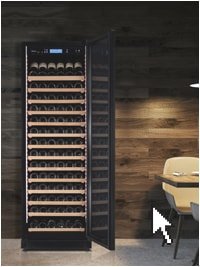
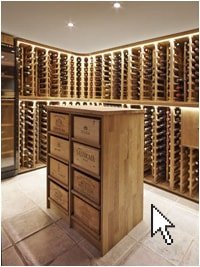
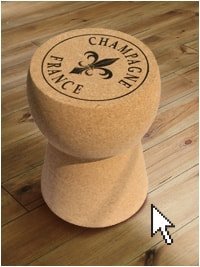
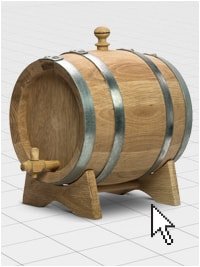
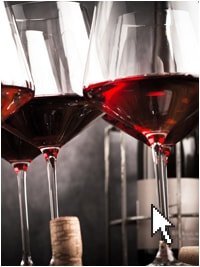
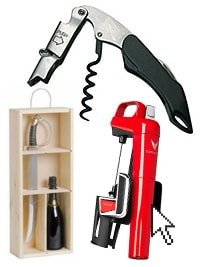
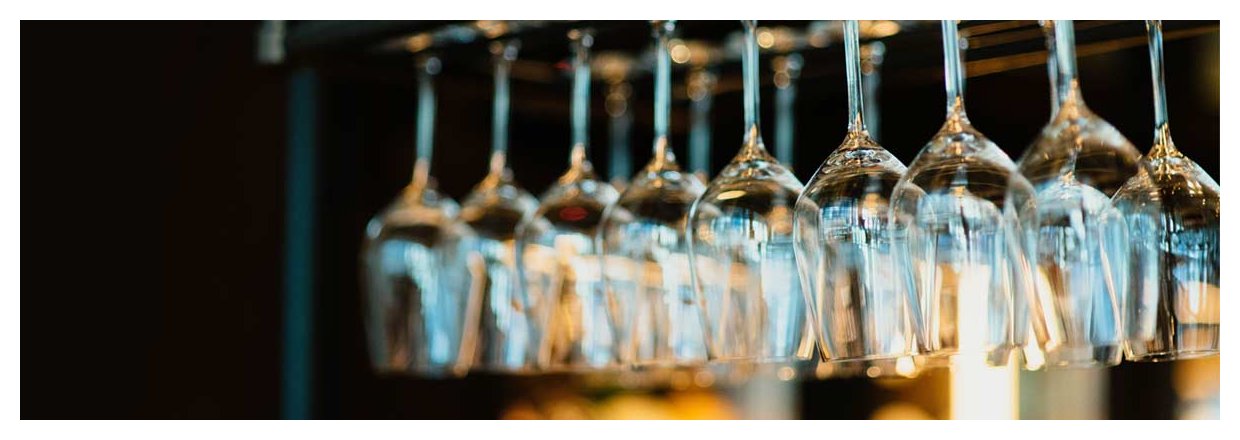

















We will publicly show your name and comment on this website. Your email is to ensure that the author of this post can get back to you. We promise to keep your data safe and secure.